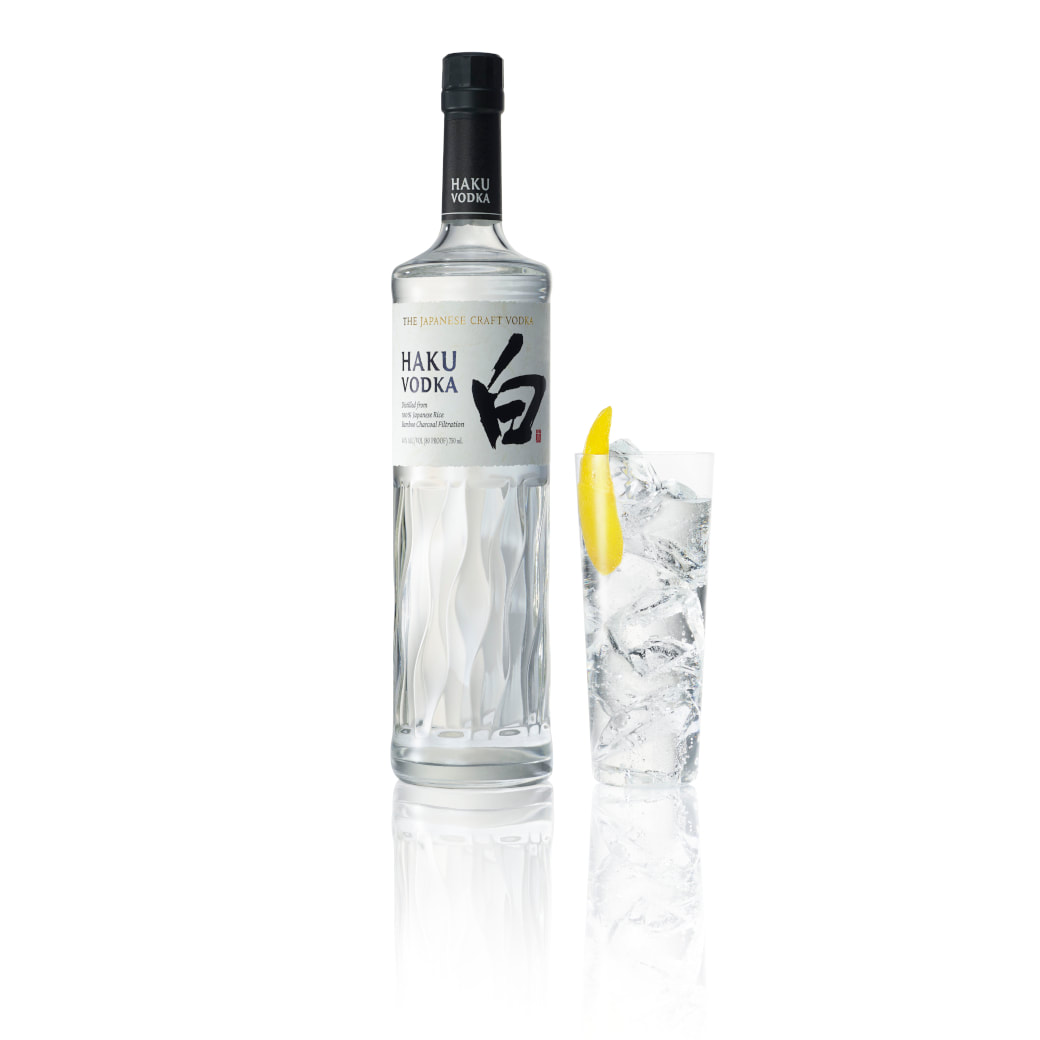- Subscribe
- Digital Edition
-
Beverage Guide
- Flavor and Cocktail Construction >
- Production Fundamentals >
- Non-Alcoholic Beverages >
-
Beer
>
- Cider >
- Sake
-
Spirits
>
-
Wine
>
- Kamaʻāina Wine Makers >
-
Winemaking
>
- A Guide to: High Sugar Residual Wines
- A Guide to: Post Fermentation Flavor Adjustments
- A Guide to: Post Fermentation Process: Stabilization
- A Guide to: Wine Prefermentation Practices
- A Guide to: Wine Microbes
- A Guide to: Wine Alcoholic Fermentation Physical Environment
- A Guide to: Wine Fermentation Chemical Environment
- A Guide to: Wine Bottling
- A Guide to: Wine Faults
- A Guide to: Wine Polyphenols
- A Guide to: Wine Aroma Compounds: Pt 1
- A Guide to: Wine Aroma Compounds: Pt 2
- A Guide to Viticulture
- Red and White Grape Aroma Compounds
- Wine Styles >
- Business Strategy
- News and Events
- About
- Production Fundamentals
- Flower Aroma Compounds
- Flavor Pairing and Recipe Development
HAKU JAPANESE VODKA
Haku Vodka, launching exclusively in the U.S. this month at a suggested retail price of $27.99 in a 750ml bottle at 40% ABV. Although Haku literally means “white,” the subtlety of the Japanese language often gives kanji (Japanese characters) several meanings. While “Haku” is rooted in the word “Hakumai,” translated as Japanese white rice, its nuanced meaning can also be elevated to evoke “Junpaku,” which connotes an untainted brilliance. This is a tribute to the craft of mastering a clear, clean and luminous vodka. This premium craft vodka is made from 100 percent Japanese white rice. The meticulous process required to mill and polish the rice attributes to its mild and subtly sweet flavor. As an iconic symbol, pure white Japanese rice conveys the House of Suntory’s commitment to working with the best and most indigenous ingredients from Japan. In Kagoshima, Kyushu, a region historically famous for its rice spirit making, the process begins with white rice fermented with koji rice to create a mash. The mash is then distilled through pot stills to create a rice spirit. It is then distilled for a second time through two different processes in a pot still and column still to create a uniquely flavored liquid. This liquid is then blended and filtered through bamboo charcoal in Osaka, Japan. This process, unique to Suntory, preserves and enhances the rice’s delicately sweet and subtle flavors. The delicate craftsmanship that goes into this liquid is complemented by its beautiful bottle. The curved lines on the Haku bottle represent the streams glistening through nature in Japan as they run through the four seasons. The label design consists of Junpaku (pure-white) washi paper – representing the beauty of Japanese white rice, the soul of this vodka – and Kanji calligraphy with sumi ink. Haku can be served neat, on the rocks or in the Haku-Hi. The liquid’s smooth and round taste suits it for many types of cocktails, but the simplicity of the Haku-Hi with chilled soda water and lemon peel particularly enhances the soft and subtly sweet flavors of the vodka. FROM SUNTORY BEAM HAKU | TASTING NOTES Nose: A soft aroma played up by the sweet, delicate floral aroma of rice. Taste: A rich taste that gradually envelops the mouth with the natural sweetness and complex flavor of the rice. Finish: A smooth finish with a sophisticated, pleasantly lingering sweetness thanks to the bamboo charcoal filtration process. ABOUT SUNTORY Suntory was established in 1899 and is headquartered in Tokyo, Japan. Since 1923, as the pioneer of Japanese whisky, Suntory Whisky has been renowned for its House of Master Blenders and for their Art of Blending. The founding father of Japanese whisky, Shinjiro Torii, built Japan’s first malt whisky distillery in Yamazaki. Nestled in the outskirts of Kyoto, this region was the birthplace of the traditional Japanese tea ceremony and is known for the purity of its waters. Torii dreamt of creating an authentically Japanese whisky by choosing a terrain and climate completely different to that of Scotland, thereby cultivating unique conditions for maturation. In 1972, Torii’s son Keizo Saji, Suntory’s second master blender, built the Chita grain distillery near Nagoya to produce more of their own high-quality grain whiskies. In 1973, Saji founded the Hakushu distillery amidst the deep forests of Mt. Kaikomagatake in the Japanese Southern Alps with the goal of producing malt whiskies distinct from those made at Yamazaki. Its high altitude and lush environment are what differentiates Hakushu from other distilleries. At each of these distilleries, a diverse array of whiskies are produced through various fermentation techniques, shapes and sizes of giant copper pot stills, and the wide variety of cask types used. Today, roughly 1,200,000 casks of whisky are quietly maturation in Suntory’s aging cellars. This tsukuriwake—variety in the making—allows for the blending opportunities that are essential to achieving the subtle, refined yet complex taste signature to Suntory Whiskies. With respect to heritage and a commitment to innovation, third generation master Blender Shingo Torii, and grandson of Shinjiro, now leads this most highly awarded house of Japanese Whisky. The House of Suntory Whisky has been named four-time Distiller of the Year at the International Spirits Challenge in London, UK (2010, 2012, 2013, 2014). The House of Suntory portfolio includes two single malt whiskies: Yamazaki – the pioneer of Japanese Single Malts, multi-layered and profound, and Hakushu – verdant, fresh, and delicately smoky; a single grain whisky: Chita—sublimely smooth, versatile and complex; and two blends: the noble blend, Hibiki – Japan’s most highly awarded blended whisky, and Suntory Whisky Toki – ideal for Japanese highballs. The introduction of Roku Japanese Gin and Haku Japanese Vodka adds two premium white spirits created from Japanese ingredients by the master artisans at the House of Suntory to the collection. Roku Gin and Haku Vodka embody Suntory founder Shinjiro Torii’s philosophy of monozukuri craftsmanship: a relentless pursuit of perfection, meticulous attention to detail and commitment to quality. Visit www.house.suntory.com for more information.
0 Comments
Leave a Reply. |
Archives
April 2019
Categories |
MENU
|
HOME
|
SUBSCRIBE |
DIGITAL
|
BEVERAGE
|
NEws and
|
ABOUT |
CONTACT |
©2022 Hawaii Beverage Guide
Terms & Conditions
Terms & Conditions
- Subscribe
- Digital Edition
-
Beverage Guide
- Flavor and Cocktail Construction >
- Production Fundamentals >
- Non-Alcoholic Beverages >
-
Beer
>
- Cider >
- Sake
-
Spirits
>
-
Wine
>
- Kamaʻāina Wine Makers >
-
Winemaking
>
- A Guide to: High Sugar Residual Wines
- A Guide to: Post Fermentation Flavor Adjustments
- A Guide to: Post Fermentation Process: Stabilization
- A Guide to: Wine Prefermentation Practices
- A Guide to: Wine Microbes
- A Guide to: Wine Alcoholic Fermentation Physical Environment
- A Guide to: Wine Fermentation Chemical Environment
- A Guide to: Wine Bottling
- A Guide to: Wine Faults
- A Guide to: Wine Polyphenols
- A Guide to: Wine Aroma Compounds: Pt 1
- A Guide to: Wine Aroma Compounds: Pt 2
- A Guide to Viticulture
- Red and White Grape Aroma Compounds
- Wine Styles >
- Business Strategy
- News and Events
- About
- Production Fundamentals
- Flower Aroma Compounds
- Flavor Pairing and Recipe Development


 RSS Feed
RSS Feed